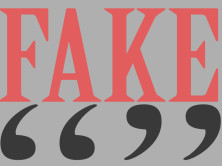See above Harper's correction. (Credit: Harper's, screenshot)
Harper’s Magazine has owned up to being tricked by a satire story by releasing corrections online, in print, and on Twitter. But, in response to its error, some of the magazine’s tweets fell flat and were misinterpreted as critical of the satirists.
In its February 2013 “Findings” section, Harper’s mentioned what turned out to be a fake lawsuit over “visual allergies.” But, that lawsuit and “visual allergies” story originated on the Canadian Broadcasting Corp’s This is That program, a satirical news program. This is That‘s segment on student Emily Stuart’s lawsuit against the University of Nanaimo over its “failure to provide visual allergy friendly ‘zones” included comments from Stuart like:
“Basically, I’m allergic to things I see with my eyes … white socks, black shoes, babies, anything with a zipper, those signs leading to different classrooms … every day for me is a battle.”

See above a screenshot of the top portion of the Findings page. Only one sentence was devoted to the visual allergies case. (Credit: Harper’s, screenshot, highlight added)
Harper‘s Jason Chupick explained to iMediaEthics by email that Harper‘s coverage of the visual allergies case was “a short sentence” as opposed to a full story on the alleged lawsuit, and emphasized that Harper’s fact checks this section.
“Findings is intended as an absurd prose poem that evokes the wonder and the folly of scientific endeavor. The section is fact-checked against the source materials, which include published studies, university press releases, band stories from reputable news organizations.”
iMediaEthics asked how the facts slipped through the cracks in this case. Chupick explained:
“The fact-checker did not listen to the entire show. He was not aware that the article was part of a specific/larger show and not a standalone news article and audio clip on the CBC’s website. Sadly, we all missed out on the rest of what must surely have been a very funny program. The checker didn’t see any indication that it wasn’t a news story; we consider CBC a respectable news source that wouldn’t ordinarily require independent verification, and in so doing missed the distinction between CBC’s news and non-news programming (of which, in the latter case, we were not aware).”
iMediaEthics asked This is That about tricking Harper’s. This is That producer Chris Kelly offered the following email’ed statement to iMediaEthics:
“This Is That, is a comedy radio show where we report fake, outlandish news stories. Because we deliver these stories in a sincere and believable style, people who don’t realize we’re doing a comedy show often think we are a news program and believe the stories, even though they’re ridiculous. We’re not as well known as The Onion and because we’re on Canada’s national broadcaster the potential for outlets outside of Canada to believe our stories is far greater. However, our ‘About’ page is only ever a click away. Our intention is never to ‘dupe the news’ but we’re flattered to have appeared in the pages of Harper’s.”
FYI, that About page explains: “That is That is a current affairs program that doesn’t just talk about the issues, it fabricates them.”
Corrections & Tweets
Harper‘s has already published corrections because of the error. In addition to the following note on the online version of the article, and a tweeted correction, Harper’s will also publish a correction in its March issue, Chupick wrote. The online correction reads:
“[*] The item about the Canadian student’s allergy-related lawsuit was based on a satirical report by a CBC radio program. We regret the error.”
Chupick added that Harper‘s learned that the visual allergies story was a sham after someone on Twitter responded to a Harper’s tweet promoting its Findings story.
But, Harper’s tweets about its error got just as much attention as its actual error. On Jan. 14, Harper’s acknowledged its error via Twitter and called the CBC “nefarious.” That tweet read
“A recent Finding reported on a Canadian student’s lawsuit. Her pain and life are lies perpetrated by the nefarious CBC. We regret the error.”
Later, Harper’s responded to the National Post’s story about the error, owned up to its mistake, and clarifying that it was kidding around when it called CBC “nefarious.” The tweet said:
“Dear impassioned Canadians: as the NatPo article (if not the headline) suggests, our tweets ‘blaming’ CBC were in jest. The error was ours.”
Harper’s also tweeted to CBC.ca reporter Kady O’Malley that it asked CBC’s ombudsman to help indicate that This is That content isn’t news, writing
“@kady Indeed. Our request that their font be changed to Comic Sans is in your ombudsperson’s hands.”
While the tweet seemed tongue-in-cheek, because of the nature of the original story being satire, iMediaEthics checked with both the CBC ombudsman, Esther Enkin, and Harper’s about any font requests. Enkin told iMediaEthics by email:
“I have heard second hand that such a request was being made. It never reached this office.
“Had it done so, I would have told the folks at Harper’s that my mandate is for news and current affairs programming so it would be out of my scope to ask this particular program to change its font.”
And Harper’s explained to iMediaEthics that the Comics Sans tweet was also “in jest” but that mis-reading it as a serious request seemed to be in line with how the whole storyline — from Harper’s running the satire story to its tweets having to clarify its “nefarious” tweet as “in jest” — had been received. Chupick responded to the confusion about Harper’s tweets that it “definitely” didn’t call for CBC to change its font and added:
“That it even bears asking goes to show how far this story travelled from the intent behind the original exchange. The tweet in question, and our initial response, were intended entirely in jest, in keeping with the satirical nature of This Is That and the humor generally woven into the Findings section, as well as into our Twitter feed, which consists mainly of interesting and often funny facts.”
Chupick went on, explaining Harper’s surprise at the reaction to its tweets and commenting on media coverage of the error:
“We were surprised that the tweets were read otherwise (‘nefarious CBC’ — seriously?), and by how rapidly the misreading spread. The National Post article stated in its lede that our intention was facetious (though they didn’t contact us to ask); however, the story appears to have been passed around largely without that context, owing perhaps to its headline. It was also widely circulated that we had reported on the existence of ‘visual allergies’; as should be clear from the context of the line in Findings, we reported on what we thought was an actual frivolous lawsuit — our aim was to underscore the absurdity of such a claim.
“We couldn’t help but be amused that by week’s end, a CBC Radio host on The Eyeopener, interviewing one of the hosts of This Is That, was referring to an error in our ‘prestigious Notes section,’ which doesn’t exist (they may have been thinking of the Harper’s Index, which is fact-checked exhaustively), while the This Is That host recounted the Twitter exchange without reference to our intended humor. It seemed as though the story had been set on its head.”
The CBC’s Chuck Thompson confirmed that during the Calgary Eyeopener, its host David Gray “did mention that this reference appeared in the ‘Notes’ section of Harper’s when in fact it appeared in the ‘Findings’ section which we illustrated on social media when we first pointed to the story.” Hear the audio of Gray’s comments. National Post‘s Tristin Hopper confirmed Chupick’s statement that National Post didn’t contact Harper’s to confirm the tweets, and explained that National Post read between the lines. By email, Hopper wrote:
“I credit a little something called ‘sense of humour.’ When a major U.S. magazine calls a major Canadian broadcaster a nefarious liar over a minor slip-up in a light-hearted monthly feature (and when the author of the message in [sic] an ex-CBC Canadian expat) it’s pretty safe to assume that no fact checking is necessary.”
iMediaEthics asked Harper’s if this incident will affect how Harper’s handles tongue-in-cheek tweets or even corrective tweets. Chupick responded with an Easter Egg in JPEG form. See below.
What’s the answer, readers? Let us know in the comments.
Earlier this month, iMediaEthics covered a similar case of a satire story gone mainstream. UK satire site News Biscuit’s joke story that Mike Tyson had a sex change got picked up as fact by African news sites. iMediaEthics looked into the stories and found denials, plagiarism and unpublishing. See Part 1 and Part 2 of our report.
Hat Tip: Huffington Post
UPDATE: 1/25/2013 5:55 PM EST: This is That producer Chris Kelly told iMediaEthics by email that after Harper‘s made its joke tweet calling for This is That to use Comic Sans font, This is That kept the “banter” going with a photo of This is That’s hosts and the show’s name in Comic Sans.
UPDATE: 1/27/2013 6:45 PM EST: Added sic in Hopper’s quote






Comments Terms and Conditions